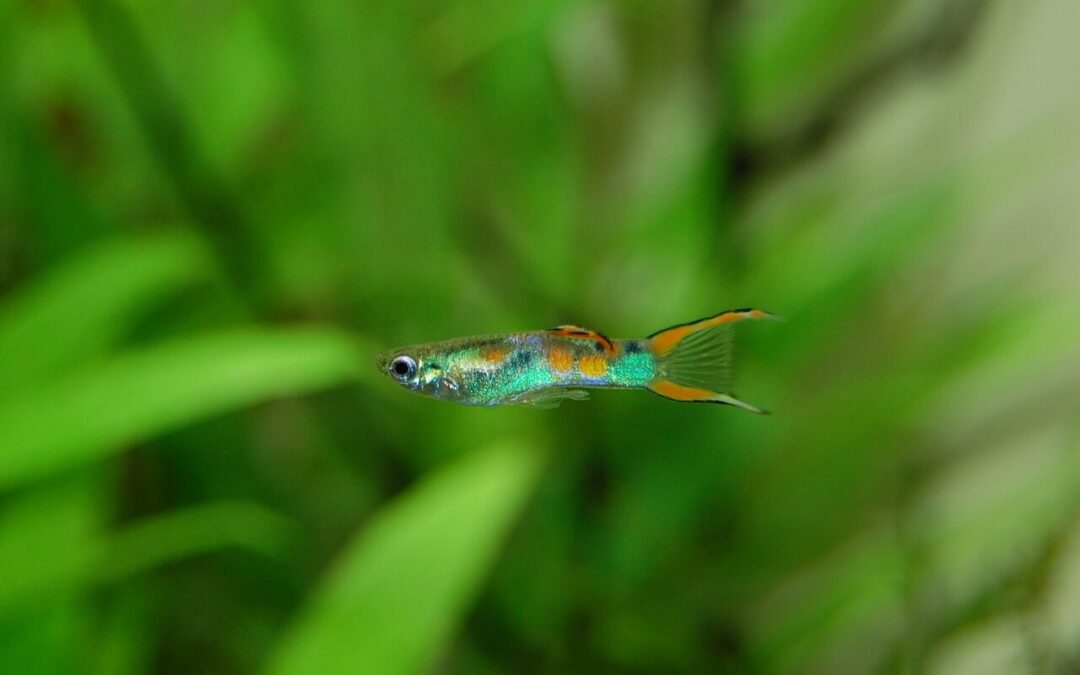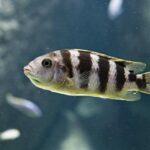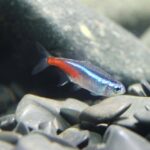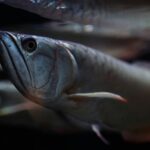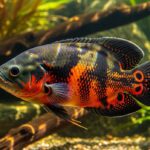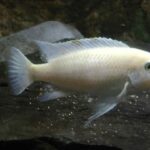When people think of guppies, they often picture small, colorful fish darting around in aquariums. They’re popular for beginners and experts alike because they’re hardy, active, and stunning to watch. But one question that always comes up for new owners is: what exactly do guppies eat?
It may surprise you to learn that guppies are not picky eaters. In fact, they’re omnivores—meaning they eat both plant-based and animal-based foods. However, feeding them isn’t just about tossing in a pinch of flakes and calling it a day. To keep your guppies healthy, vibrant, and full of energy, their diet should be balanced, varied, and carefully portioned.
In this guide, we’ll break down everything you need to know about guppy diets, including the best commercial foods, live and frozen treats, plant-based options, homemade alternatives, and feeding tips to help your guppies thrive.
Understanding Guppy Eating Habits
One of the reasons guppies are so fun to keep is because of their lively personalities—and feeding time is when this really shines through. Guppies are surface feeders, which means they spend most of their time at the top or middle of the tank, eagerly waiting for food to hit the water. Unlike bottom-feeders such as catfish, guppies won’t scavenge much on the substrate, so it’s important to feed them foods that stay accessible near the surface.
Another thing to keep in mind is that guppies have small stomachs. Despite their tiny size, they’re surprisingly greedy and will keep eating if you let them. This is why portion control is so crucial. Too much food not only harms them but also pollutes the water.
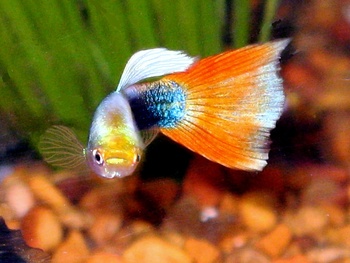
Live Foods vs. Prepared Foods
One of the biggest questions new owners ask is: Do guppies really need live food?
The short answer is no, but they’ll definitely benefit from it. Live foods like brine shrimp, mosquito larvae, or daphnia are close to what guppies would eat in the wild. They add variety, provide high levels of protein, and keep your guppies active since they instinctively chase moving prey.
Prepared foods, like flakes and pellets, are still essential because they’re balanced and easy to use. However, relying solely on them can sometimes lead to nutritional gaps. A good routine is to feed flakes or pellets daily, then supplement with live or frozen food two to three times per week.
For many keepers, frozen options are the perfect middle ground—they’re just as nutritious as live food but much easier to store and handle.
Feeding Baby Guppies (Fry)
Feeding adult guppies is one thing, but raising fry is another challenge altogether. Since guppies give birth to live young (instead of laying eggs), their babies are independent right from birth. They need food immediately to survive and grow.
- How often to feed fry: 3–5 times daily in small amounts.
- Best foods: Crushed flakes, powdered fry food, baby brine shrimp, and microworms.
- Why it matters: A protein-rich diet helps them grow quickly, while frequent meals mimic the constant feeding they’d do in the wild.
If you’re breeding guppies, keep in mind that adult guppies sometimes eat their fry. Using a breeding box or providing lots of hiding spots like plants and moss will help more fry survive.
Seasonal Feeding Adjustments
Believe it or not, even aquarium fish like guppies can benefit from slight changes in their feeding routine depending on the season.
- Summer: Higher temperatures speed up their metabolism, meaning they may need slightly more food. Adding extra protein-rich meals helps maintain energy.
- Winter: If the room or tank water is cooler, guppies move less and need less food. Overfeeding during this time can quickly pollute the water.
These small adjustments make a big difference in keeping your guppies healthy year-round.
Signs of a Healthy (and Unhealthy) Diet
Sometimes, the best way to know if your feeding routine is working is by observing your fish. Guppies show very visible signs of good or poor nutrition.
Signs of a Healthy Diet:
- Bright, vivid colors
- Active swimming and playful chasing
- Clear eyes and smooth fins
- Strong breeding activity
Signs of Poor Diet:
- Faded or dull colors
- Lethargy or hiding often
- Torn or clamped fins
- Bloated belly or stringy white waste (indicating digestive issues)
If you notice any of these issues, it may be time to review your feeding routine and add more variety or cut back on excess treats.
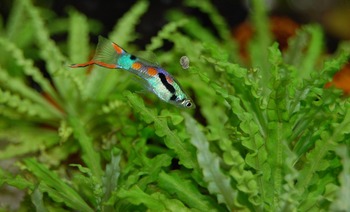
Comparing Guppy Diets with Other Fish
It’s helpful to know how guppies’ feeding habits differ from other common aquarium fish.
- Goldfish: Primarily omnivores too, but they produce more waste and need specialized diets to prevent digestive problems.
- Betta Fish: Bettas are carnivores that need more protein, while guppies require a balanced mix of plant and protein-based foods.
- Tetras: Similar to guppies, but often eat smaller portions more frequently.
Knowing these differences helps when keeping mixed-species aquariums. A community tank should have a feeding routine that keeps everyone happy without overfeeding.
Why a Balanced Diet Matters for Guppies
Guppies are small, but they burn through a lot of energy with their constant swimming. Their growth, coloration, and even breeding success depend heavily on proper nutrition.
A poor diet can lead to:
- Faded colors
- Sluggish behavior
- Weak immune systems
- Poor breeding results
- Shortened lifespans
A varied diet ensures they get all the essential proteins, vitamins, and minerals they need. Just like us, guppies thrive on diversity in their meals.
Commercial Foods for Guppies
1. Flakes and Pellets
High-quality flakes and micro-pellets formulated for tropical fish are the foundation of most guppy diets. They’re convenient and nutritionally balanced.
- Flakes: Great for surface feeders like guppies. Choose brands that are rich in protein and vitamins.
- Pellets: Some guppies prefer sinking micro-pellets. Look for small sizes that fit their tiny mouths.
💡 Tip: Avoid low-quality generic flakes—they often contain fillers with little nutritional value.
2. Frozen and Freeze-Dried Foods
Adding frozen or freeze-dried foods to your guppies’ meals keeps things exciting and nutrient-rich.
- Brine Shrimp: Packed with protein and a favorite for encouraging breeding.
- Daphnia: Helps with digestion and is a great natural laxative for guppies.
- Bloodworms: A protein-rich treat, but should be fed sparingly to avoid digestive issues.
3. Other Protein Options
- Mosquito Larvae: Nutritious and loved by guppies (though not always easy to source).
- Spirulina-based foods: Excellent for supporting immunity and enhancing colors.
Plant-Based Foods for Guppies
Even though guppies enjoy meaty foods, plants and veggies are just as important. These provide fiber, vitamins, and natural grazing opportunities.
1. Vegetables
You can offer softened or blanched vegetables a couple of times a week. Some good options include:
- Spinach
- Peas (shelled and crushed)
- Carrots
- Pumpkin
To prepare: microwave or boil them lightly until soft, or blend them into a paste and freeze small portions for later.
2. Algae
Guppies will happily nibble on algae in your aquarium. While it shouldn’t be their only food source, it’s a natural and beneficial supplement.
The Role of Plants in a Guppy Diet
If you have a planted tank, your guppies already have a bonus snack bar. They often nibble on soft leaves, graze algae, and even pick at tiny microorganisms that live on plants.
Popular plants for guppy tanks include:
- Java moss (great hiding spot for fry and micro-food source)
- Anubias
- Hornwort
- Water wisteria
Not only do these plants help balance water quality, but they also provide natural grazing opportunities that mimic a wild diet.
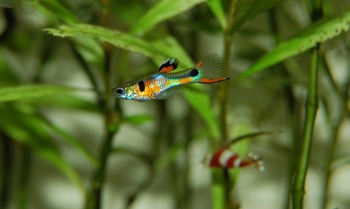
Homemade Foods for Guppies
If you want more control over your guppies’ diet, you can make homemade foods.
- Paste Foods: Blend shrimp, spinach, peas, or fish meal into a paste, then freeze it in small cubes.
- Fruit Flies: A natural snack that guppies enjoy catching. Just leave out some fruit, collect the flies, and let your guppies feast.
Homemade options can be fun and rewarding, but remember to keep them balanced and varied.
How to Prepare Vegetables for Guppies
Offering veggies to guppies is simple, but a little preparation goes a long way. Here’s how to do it:
- Choose fresh vegetables: Spinach, peas, zucchini, cucumber, and pumpkin are great choices.
- Blanch them: Briefly boil or microwave until they’re soft but not mushy.
- Cool down: Always let them cool before adding to the tank.
- Cut into small pieces: Guppies have tiny mouths, so smaller is better.
- Remove leftovers: After a few hours, scoop out any uneaten vegetables to prevent water contamination.
Feeding Tips for Guppy Owners
Feeding guppies isn’t complicated, but there are a few rules that will make your life easier and your fish healthier:
- Variety is Key: Don’t rely on just flakes. Rotate between flakes, live/frozen foods, and veggies.
- Feed Small Amounts: Only give what they can eat in 1–2 minutes. Overfeeding leads to water pollution and unhealthy guppies.
- Frequency: Adult guppies can be fed 1–2 times daily. Fry (baby guppies) may need 3–5 smaller feedings to support rapid growth.
- Remove Leftovers: Always scoop out uneaten food after feeding to keep the water clean.
- Observe Your Fish: Watch how they eat. Healthy guppies are active eaters, and any changes in appetite could signal illness.
Common Feeding Mistakes to Avoid
Even experienced fishkeepers can slip up when feeding guppies. Here are the top mistakes to watch out for:
- Overfeeding: The most common mistake—leads to obesity, bloating, and dirty water.
- Feeding only one type of food: Guppies need variety. Sticking to just flakes is not enough long term.
- Ignoring fry needs: Fry require more frequent meals than adults.
- Leaving uneaten food in the tank: This breaks down into harmful ammonia.
- Not adjusting feeding frequency: Smaller, more frequent meals are better than one large portion.
Foods to Avoid
Not all foods are safe for guppies. Stay away from:
- Bread or processed human foods (they cause bloating and water quality issues)
- Fatty meats (too heavy for guppies’ digestion)
- Overfeeding protein-rich treats like bloodworms
Interesting Facts About Guppy Feeding
- Guppies are sometimes called “millionfish” because of their fast breeding rate. A varied diet helps females produce healthier fry.
- In the wild, guppies feed on mosquito larvae, algae, and plant matter. Mimicking this variety in aquariums makes them more vibrant.
- Baby guppies start eating as soon as they’re born—they don’t need parental care to survive.
- Spirulina in their diet can make guppies’ colors brighter and more intense.
Fun Feeding Ideas
Feeding time doesn’t have to be routine—it can also be enriching for your guppies.
- Use a feeding ring: Keeps food from spreading all over the tank, making it easier to monitor intake.
- Drop in live food occasionally: Watching guppies chase brine shrimp or daphnia is both entertaining and natural for them.
- DIY veggie clips: Use suction clips to attach spinach or zucchini slices to the glass so guppies can nibble at their leisure.
Long-Term Benefits of a Proper Diet
When you commit to feeding your guppies a well-rounded diet, you’ll notice benefits that go beyond just good health.
- Enhanced Colors: A varied diet, especially with spirulina or carotenoid-rich foods, makes guppies’ reds, blues, and yellows pop.
- Improved Breeding: Females produce stronger fry, and males display brighter courtship colors.
- Disease Resistance: Proper nutrition boosts immunity and reduces the chances of common guppy illnesses like fin rot or ich.
- Longer Lifespan: Well-fed guppies can live up to 3–5 years, compared to 1–2 years with poor diets.
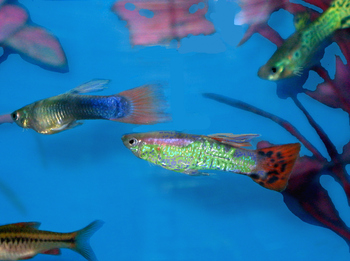
FAQs About Guppy Diets
1. What is the best food for guppies?
A mix of high-quality flakes or pellets, live or frozen foods like brine shrimp and Daphnia, and occasional plant-based foods such as blanched spinach or peas is best.
2. How often should I feed guppies?
Adults should be fed once or twice a day. Fry need more frequent feedings, usually 3–5 times daily.
3. Can guppies eat vegetables?
Yes! Spinach, peas, and zucchini are all safe when softened. These help with digestion and provide essential nutrients.
4. Do guppies eat algae?
They do. While guppies graze on algae in the tank, it shouldn’t replace a balanced diet.
5. Can guppies eat human food?
Most human foods aren’t suitable. Avoid bread, processed snacks, or fatty meats. Stick to vegetables and fish-safe ingredients.
6. What happens if I overfeed guppies?
Overfeeding can lead to bloating, constipation, and polluted water, which increases the risk of disease. Always feed small amounts.
7. Can guppies survive on flakes alone?
They can survive, but they won’t thrive. Adding variety through live, frozen, or plant-based foods will keep them healthier and more colorful.
Final Thoughts
Feeding guppies the right diet isn’t difficult, but it does require variety and balance. Think of it this way—if you only ate one type of food every day, you’d eventually feel sluggish and unhealthy. Guppies are no different.
By offering high-quality flakes or pellets, supplementing with protein-rich foods like brine shrimp and Daphnia, and tossing in some blanched veggies every now and then, you’ll give your guppies everything they need to thrive.
Happy, well-fed guppies reward you with bright colors, active behavior, and even healthy fry if you’re breeding them. With a little effort, your aquarium will be full of life, movement, and beauty.

